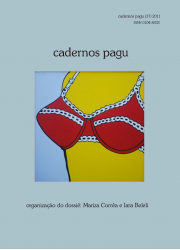Resumo
O contexto é a Partição da Índia em 1949, que levou à criação do Paquistão, visto a partir da cultura punjabi (o Punjab era a província mais próxima da fronteira com o novo estado) e, particularmente, através dos olhos de Asha que, aos 21 anos, em 1941, ficara viúva e passara a viver com a família do falecido marido. As transformações impostas pela Partição alteraram essa situação e levaram Asha às seguintes reflexões. A comida de uma filha nunca é pesada para os pais. Mas quanto viverão nossos pais? Quando até dois pedaços de pão são sentidos como “pesados” por nosso próprio irmão... é melhor manter a honra ... e fazer sua paz... e viver onde se está destinada a viver. A exegese dessas reflexões constitui o núcleo analítico do texto. E, sobre a partição, a autora não se pergunta como os acontecimentos estavam presentes nas consciências como acontecimentos passados, mas como vieram a ser incorporados na estrutura temporal das relações.
Abstract
The context is the Partition of India in 1949, with the creation of Pakistan, as seen from the point of view of Punjabi culture (the Punjab was the province closer to the frontiers of the new state) and particularly through the eyes of Asha, a widow 21 years old in 1941, who lived with his deceased husband‟s family. The transformations derived from the Partition give rise to Asha‟s following reflections. A daughter’s food is never heavy on her parents. But how long will one’s parents live? When two pieces of bread are experienced as heavy by one’s own brother… then it is better to keep one’s honor… make one’s peace … and live where one was destined to live. The exegesis of this text is the analytical nucleus of the text. The author is not asking how the events of the Partition were present to consciousness as past events but how they came to be incorporated into the temporal structure of relationships.
Key Words: Partition of India, Violence, Gender, Family History, Punjab
Referências
BENNETT, Lynn. Dangerous Wives and Sacred Sisters: Social and Symbolic Roles of High-Caste Women in Nepal. New York, Columbia University Press, 1983.
BOURDIEU, Pierre. The Logic of Practice. Stanford, Stanford University Press, 1990.
BUTLER, Judith. The Psychic Life of Power: Theories in Subjection.
Stanford, Stanford University Press, 1997.
CAVELL, Stanley. In Quest of the Ordinary: Lines of Skepticism and Romanticism. Chicago, University of Chicago Press, 1988.
__________. Disowning Knowledge in Six Plays of Shakespeare.
Cambridge, Cambridge University Press, 1987.
CHANTER, Tina. Ethics of Eros: Irigaray’s Re-writing of the Philosophers.
Nova York, Routledge, 1995.
DESJARLAIS, Robert. Sensory Biographies: Lives and Deaths among Nepal’s Yolmo Buddhists. Berkeley, University of California Press, 2003.
EGNOR, Margaret [now Margaret Trawick]. Internal Iconicity in Paraiyar "Crying Songs." In: BLACKBURN e RAMANUJAN (eds.) Another Harmony: New Essays on the Folklore of India. Oxford and Delhi, Oxford University Press, 1986, pp.294-344.
FOUCAULT, Michel. Discipline and Punish: The Birth of the Prison. Nova York, Pantheon Books, 1977.
GADAMER, Hans-Georg. The Hermeneutics of Suspicion. In: MOHANTY, J.N. (org.) Phenomenology and the Human Sciences. Boston, Martinus Nijhoff, 1985, pp.73-85.
GIORGIO, Agamben. Remnants of Auschwitz: The Witness and the Archive. Nova York, Zone Books, 1999 [trad.: Daniel Heller-Roazen].
GOLD, Ann G. e RAHEJA, Gloria G. (orgs.) Listen to the Heron’s Words: Reimagining Gender and Kinship in North India. Berkeley, University of California Press, 1994.
GOOD, Byron. Medicine, Rationality and Experience: An Anthropological Perspective. Cambridge, Cambridge University Press, 1994.
HEGEL, George W.F. The Philosophy of Fine Art, vol. 2. Londres, G. Bell & Sons, 1920 [trad.: F.P.B. Osmaston].
HILTEBEITEL, Alf. Draupadi‟s Hair. In: BIARDEAU, Madeleine. (org.) Autour de La déesse hindoue, Purusartha 5, 1981, pp.179-214.
IRIGARAY, Luce. Speculum of the Other Woman. Ithaca, Cornell University Press, 1985 [trad.: Gillian C. Gill].
JACOBS, Carol. Dusating Antigone. Modern Language Notes, III, nº 5, 1996, pp.890-917.
LACAN. The Splendor of Antigone. In: MILLER, Jacques-Alain. (org.) The Ethics of Psychoanalysis: The Seminars of Jacques Lacan, Livro VII.
New York, W.W. Norton, 1997, pp.243-57 [trad.: Russel Grigg].
MACCANNELL, J.F. Figuring Lacan: Criticism and Cultural Unconscious.
Londres, Croomhelm, 1986.
MARTIN, Jay. Downcast Eyes: The Denigration of Vision in TwentiethCentury French Thought. Berkeley, University of California Press, 1993.
MOHANTY. J. The Status of the Subject in Foucault. In: CAPUTO, John e YOUNG, Mark. (orgs.) Foucault and the Critique of Institutions.
University Park, Pennsylvania State University Press, 1993.
NICHOLAS, Ralph W. The Effectiveness of the Hindu Sacrement (samaskara): Caste, Marriage, and Divorce in Bengali Culture. In: HARLAN, Lindsey e COURTRIGHT, Paul B. (orgs.) From the Margins of Hindu Marriage: Essays on Gender, Religion, and Culture. New York, Oxford University Press, 1995.
OBEYESEKERE, Gananath. The Cult of the Godess Pattini. Chicago, University of Chicago Press, 1984.
NUSSBAUM, Martha C. The Fragility of Goodness: Luck and Ethics in Greek Tragedy and Philosophy. Cambridge, Cambridge University Press, 1986.
WITTGENSTEIN. Philosophical Investigations. Nova York, Macmillan, 1953 [trad.: G.E.M. Enscombe].

